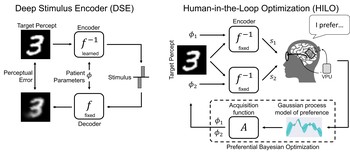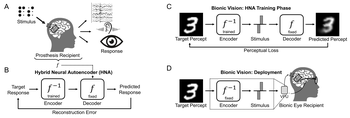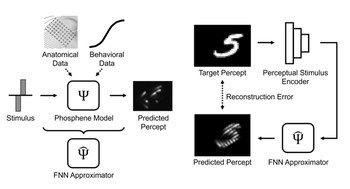We propose a personalized stimulus encoding strategy that combines state-of-the-art deep stimulus encoding with preferential Bayesian optimization.
End-to-End Optimization of Bionic Vision
Our lack of understanding of multi-electrode interactions severely limits current stimulation protocols. For example, current Argus II protocols simply attempt to minimize electric field interactions by maximizing phase delays across electrodes using ‘time-multiplexing’. The assumption is that single-electrode percepts act as atomic ‘building blocks’ of patterned vision. However, these building blocks often fail to assemble into more complex percepts.
The goal of this project is therefore to develop new stimulation strategies that minimize perceptual distortions. One potential avenue is to view this as an end-to-end optimization problem, where a deep neural network (encoder) is trained to predict the electrical stimulus needed to produce a desired percept (target).
Importantly, this model would have to be trained with the phosphene model in the loop, such that the overall network would minimize a perceptual error between the predicted and target output. This is technically challenging, because a phosphene model must be:
- simple enough to be differentiable such that it can be included in the backward pass of a deep neural network,
- complex enough to be able to explain the spatiotemporal perceptual distortions observed in real prosthesis patients, and
- amenable to an efficient implementation such that the training of the network is feasible.

Project Lead:
PhD Candidate
Project Affiliate:
Principal Investigator:
Assistant Professor
Collaborator:
Professor
Universidad Miguel Hernández, Spain
DP2-LM014268:
Towards a Smart Bionic Eye: AI-Powered Artificial Vision for the Treatment of Incurable Blindness
PI: Michael Beyeler (UCSB)
September 2022 - August 2027
Common Fund, Office of the Director (OD); National Library of Medicine (NLM)
National Institutes of Health (NIH)
Publications
Human-in-the-loop optimization for deep stimulus encoding in visual prostheses
Jacob Granley, Tristan Fauvel, Matthew Chalk, Michael Beyeler 37th Conference on Neural Information Processing Systems (NeurIPS) ‘23
Hybrid neural autoencoders for stimulus encoding in visual and other sensory neuroprostheses
What is the required stimulus to produce a desired percept? Here we frame this as an end-to-end optimization problem, where a deep neural network encoder is trained to invert a known, fixed forward model that approximates the underlying biological system.
Jacob Granley, Lucas Relic, Michael Beyeler 36th Conference on Neural Information Processing Systems (NeurIPS) ‘22
Deep learning-based perceptual stimulus encoder for bionic vision
We propose a perceptual stimulus encoder based on convolutional neural networks that is trained in an end-to-end fashion to predict the electrode activation patterns required to produce a desired visual percept.
Lucas Relic, Bowen Zhang, Yi-Lin Tuan, Michael Beyeler ACM Augmented Humans (AHs) ‘22


